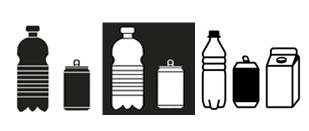Collection, deposit and reception of other waste generated from the operation of the vessel

Part C of the Implementing Regulation concerns other waste produced in the course of operating vessels other than the waste in parts A (oily and greasy waste) and B (cargo-related waste). What this means for boatmasters is that they must, if possible, sort domestic waste as follows:
- paper,
- glass,
- rigid plastics/synthetic materials,
- packaging waste (synthetic, metal, or cardboard),
- residual waste,
- other waste.
Other categories may also constitute waste:
- domestic waste water (galley, washrooms and faecal water),
- sludge (from an on-board sewage-treatment plant),
- slops (cargo residues mixed with swilling-out water, rust and sludge, which may or may not be suitable for pumping),
- special waste (chemical, electric, electronic, paint residue, etc.).
Method applied
As for parts A and B, the Convention prescribes a general ban on the dumping and discharging of this waste.
Two steps are essential in avoiding any discharge into the waterway:
- 1) on-board collection: if possible, the waste needs to be collected, sorted, and stored on board in appropriate containers;
- 2) depositing ashore: the waste is handed over to dedicated infrastructure.
Comment: with effect from 1 January 2025, the ban on the dumping and discharging of domestic waste water will also apply to vessels with more than 12 passengers (not only to vessels with more than 50 passengers). Vessels that entered service before 2008 that lack the appropriate technical equipment will be subject to transitional provisions.
Financing and responsibility
The boatmaster is the guarantor for ensuring the collection and selective sorting on board, and that the waste is deposited ashore. When a passenger vessel has an on-board sewage treatment plant, it is the latter’s operator who is responsible for depositing the sludge.
The financing is regulated differently for the different types of waste.
The regulations for cargo vessels aim to create a level of equipment and type of financing similar to those already available “on the quays”. These include:
- readily accessible waste reception stations, located close to sites where vessels moor,
- appropriate onboard receptacles for the different types of domestic waste, featuring the corresponding symbol,
- a type of financing for which, depending on the type of waste, the boatmaster contacts the relevant manager at these reception stations.
Household waste can thus be deposited in ports, preferably separated into waste streams: paper, glass, rigid plastics/synthetic materials, packaging waste (synthetic, metal or cardboard), residual waste, and other waste. In certain locations, the deposit points are restricted to one or more waste types. A financial contribution may be required for the depositing of special waste. This may be non-paying in certain reception facilities.
Tools
For domestic wastewater, there are dedicated systems for passenger vessels (more than 12 passengers):
- collection on board (tanks) and discharge into the sanitation systems in ports and at moorings, or
- collection on board (tanks) followed by collection via a mobile reception station for subsequent transport and treatment, or
- treatment of the water on the vessel in type-approved sewage treatment plants, water which can then be discharged into the waterway. As for the sludge, it is dealt with by specialist companies.
To avoid detours, the reception facilities for other waste must be easily accessible and located close to where vessels moor. These may be handling facilities, passenger vessel wharves, moorings, and locks.
The collected domestic refuse is to be stored on board in appropriate collection receptacles displaying the relevant symbols. The CDNI website contains guidelines with examples of symbols that boatmasters may find useful.

Example of packaging waste symbols
Local waste regulations and national regulations may exhibit marked differences. Account also needs to be taken of different equipment levels between countries and ports. The inland navigation sector is familiar with this type of situation. Work is in progress to enable better coordination and optimisation at international level.
The reception stations are listed on an interactive map on the CDNI website. There is a filter for identifying the nearest station that is suited to the boatman’s needs (contact information and opening hours).
Documents
- 10 years of implementation of the CDNI
- CDNI guidelines on waste streams sorted and stored on board and on the corresponding symbols-based signage
